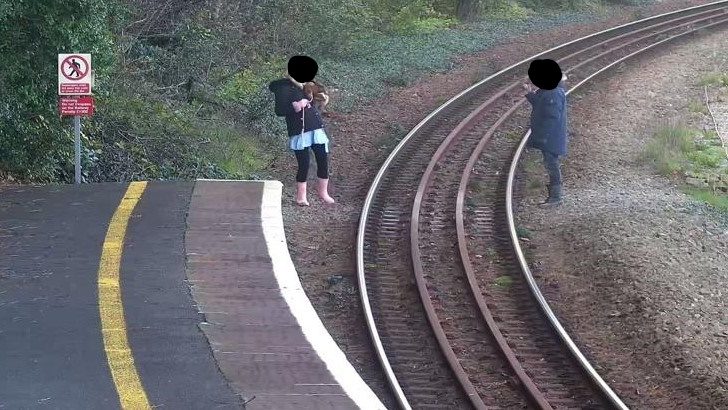How can we prevent trespassing on the tracks?
Posted: 3 April 2024 | Emily Budgen | No comments yet
As spring has sprung in the UK, there has been a noted rise in trespassing incidents across Network Rail infrastructure.


“Trespassing on the railway is illegal and can cause life-changing injuries or death.”
Network Rail have released the above statement responding to the rise in trespassing incidents, advising people to adhere to the safety rules and regulations already in place.
As a child of the early 2000s, I am still to this day haunted by the boy who didn’t ‘stop, look, and listen’, a ghostly cartoon warning of the harrowing fates of children who don’t follow correct procedures when crossing roads.
Fast forward a decade and I was in secondary school, learning about the dangers of the ‘third rail’, what would happen if one tried to take a shortcut across a railway line, and the importance of respecting the safety regulations already in place – an assembly with an equally nightmare-inducing accompanying video. Around the same time, everyone was singing along to ‘Dumb Ways to Die’, the musical internet sensation which warned against thoughtless behaviour around rail infrastructure, such as driving around boomgates at a level crossing.
However graphic the warnings, they did their job. The dangers of ignoring safety procedures were seared in my mind.
Such information on safety around transport routes and infrastructure has been around for decades, complete with eerie deterrent cartoons, yet the number of accidents on rail infrastructure is rising.
Railway trespassing is still a major problem, with the number of incidents increasing by 11%, and fatalities by 85% in 2023-4, compared to 2022-3.
However, this is a recurring pattern. Figures show that the number of trespass incidents spike during the month of April, possibly due to the longer, brighter evenings, in both 2022 and 2023.
As we are now in British Summer Time, Network Rail have released a statement, reminding people that:
- Trains can travel at speeds up to 125 mph – their breaking distance can be up to the lengths of 20 football pitches to come to a complete stop.
- The electricity used to power the railway, 25,000 volts in the overhead cables and 750 volts in the third rail, is on 24 hours a day.
- The source of electricity does not have to be touched to cause harm – electricity can jump and arc. Safe distances must always be maintained.
“The railway is an incredibly dangerous environment and those who trespass are breaking the law and risking their lives,” said Innis Keith, health, safety and environment director, Network Rail Scotland.
“The impact of choosing to go on to the tracks can be devastating, not just for those who sadly end up with lifechanging injuries or worse, but for their families and railway staff who can be traumatised by these events.
“Added to that is the huge cost to passengers who miss important appointments, to businesses whose people can’t get to where they need to be, and to the emergency services who have to use vital resources on responding to these incidents.”
Network Rail have estimated that trespassing, with the resulting train delays and cancellations, costs the rail industry £60 million each year, across Scotland, England, and Wales. The wider economic costs can run up to hundreds of millions.
“No-one wants to see people come to harm so we’re urging everyone to ensure they and their loved ones stay safe, stay off the tracks,” Keith added.
There are already several schemes in place, educating the public about the dangers of trespassing on the railway. 140,000 children and youths have benefitted from safety workshops, run by the Scottish Football Association, during local football camps, with a further 3600 workshops planned to take place before 2027.
Network Rail and the British Transport Police have likewise teamed up to raise awareness, running the ‘You vs Train’ campaign, educating the public on the dangers present on the railway line, and deterring trespassing, since 2018.
Other operators have likewise created their own schemes, adapting their material for a younger, and more vulnerable audience.
Back in 2021, operator South Western Railway (SWR) invested £40,000 in a partnership with UK Youth, to help educate young people about the dangers of trespassing and vandalism.
The project is aimed at people aged 11 to 25, who may come from a disadvantaged background. This scheme has a similar workshop format to the one run by the Scottish FA, with young people attending different sessions and activities which raise awareness of rail safety.
“UK Youth is very grateful to South Western Railway for this funding, which will enable us to use outdoor learning as a powerful tool to educate young people on the risks associated with railways,” David Watts, Director of Outdoor Learning, UK Youth, said in 2021.
“Following the additional challenges Covid-19 has sadly brought for young people over the past 18 months, providing young people with opportunities such as this that utilise outdoor learning and physical activity to deliver vital life skills, and support good citizenship, have never been more important.”
Readers wanting to learn more about rail safety and the dangers of trespassing can follow this link, www.youvstrain.co.uk.
More Like This
International Women’s Day: Wisdom from women in rail
Rail Infrastructure Asset Management Summit (RIAMS) 2024
Romania: infrastructure investment and regional leadership
Related topics
Related organisations
British Transport Police, Network Rail, Scottish Football Association, South Western Railway (SWR), UK Youth






